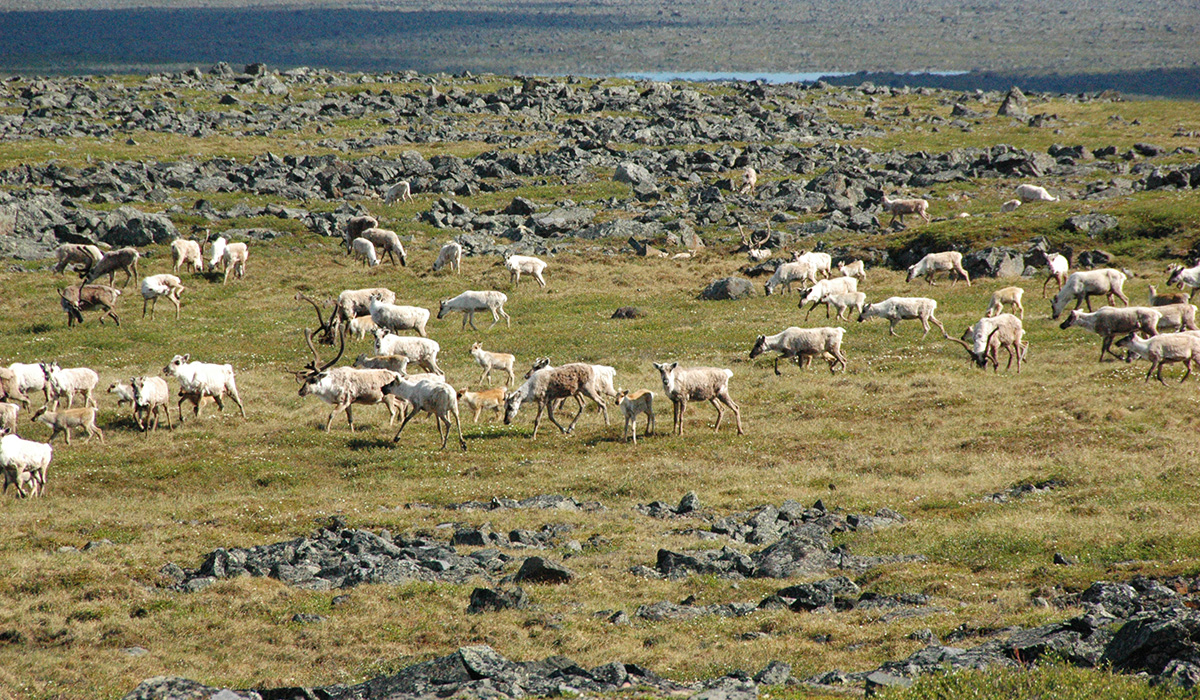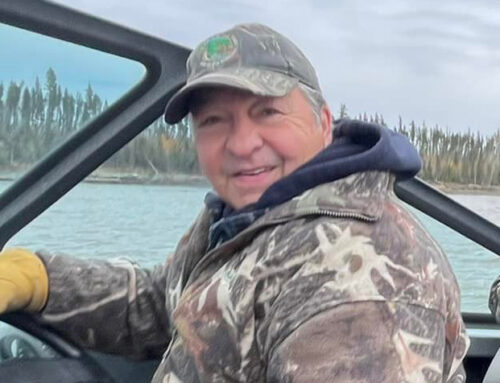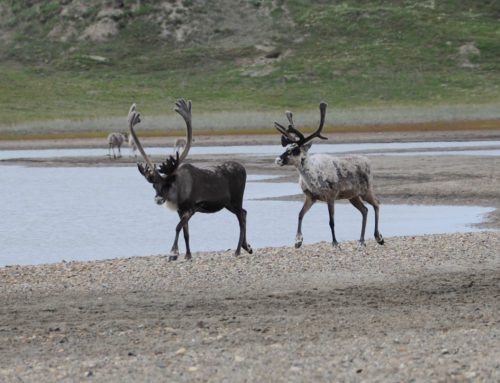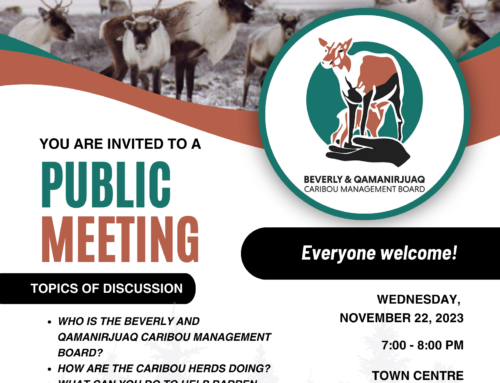HTOS HELP WITH CARIBOU MONITORING
With the endorsement of the Baker Lake and Arviat Hunters and Trappers Organizations (HTOs), the BQCMB’s Caribou Monitoring Project will head into the second round of interviews with hunters this fall.
Last fall, project organizers hired Sarah Silou of Baker Lake and Mike Curley of Arviat to interview 40 hunters from their communities about caribou, conditions on the land and water, and ongoing changes. The BQCMB caribou monitoring project is studying caribou, caribou range, and community usage in relation to changing climate and land use activities such as mines and roads. The Nunavut interviews kicked off a long-term community-based caribou monitoring program that will provide local and traditional knowledge to complement science-based monitoring taking place across the caribou range.
Nunavut licensing requirements postponed plans to stage more interviews this spring. The BQCMB must fulfil this requirement and other conditions before obtaining funding for 2002/03 work from the Nunavut Wildlife Management Board (NWMB), which has approved $20,000 in new funding. A further $23,000 in new funds is being provided by Environment Canada’s Northern Ecosystem Initiative (NEI) and the BQCMB is contributing $10,000.
The second round of interviews will concentrate on hunters’ observations during the preceding year (winter 2001/02 to fall 2002), and canvass Baker Lake and Arviat elders on historical aspects of caribou.
In a May meeting between the BQCMB and the Baker Lake HTO, it was also agreed the HTO would help to improve the interview questions, choose who would do the interviews, and identify hunters and elders to be interviewed.
“We were very impressed with presentations that (the BQCMB) made which made a lot of sense, but we have to absorb it and read the material that they will be providing,” said Thomas Kudloo, an HTO member, former vice-president, and chairman of the Nunavut Water Board.
Arviat HTO members met a few days later with project organizers Leslie Wakelyn and Gary Kofinas. The Arviat HTO “fully supported that program,” reported manager Hannah Muckpah. The HTO subsequently sent a letter of support to NWMB, encouraging the project to continue in the fall. It also agreed to help with interview questions, to select an interviewer, and to choose hunters and elders to be interviewed.
Baker Lake HTO members said they were pleased biologists and hunters were working together on the project, and suggested some improvements. They stressed the importance of a skilled bilingual interviewer who fully understands the answers, including the technical language used by elders and other hunters.
They also suggested that tape recorders could be used for future interviews, so that conversations can be clarified later if necessary.
Baker Lake elder Norman Attungala urged the caribou monitoring project to examine the cumulative effects of climate change. He pointed out that water levels have been dropping over the past 50 years.
In the months leading up to round two of interviews, Wakelyn will compile scientific information about monitoring indicators in a project database, She will also expand the web-based reporting system that began last year (for more information, see the web site www.taiga.net/bq). Before posting information from the interviews with Arviat and Baker Lake hunters, or distributing it in reports, project staff will work with HTOs to find out what they are comfortable with making public.
At the board’s May meeting, Baker Lake HTO member Phillip Putumiraqtuq requested Inuktitut versions of articles about the monitoring project that have been published in Caribou News in Brief. Wakelyn agreed to have them translated, saying she would send Inuktitut articles to the Baker Lake and Arviat HTOs, and aim for wider distribution throughout the Kivalliq region as well.
AROUND THE RANGE
Keen minds win awards
University of Alberta PhD student Keri Zittlau has earned another BQCMB Caribou Management Scholarship award for her continuing study of DNA to figure out the genetic variation, gene flow and herd range boundaries of the Beverly and Qamanirjuaq, Bathurst and Ahiak caribou. DNA is the chemical in humans and animals that decides what they will look and be like.
University of Manitoba student Jennifer Yantz also won a Scholarship award. She will integrate traditional knowledge, including knowledge about caribou and their habitat, into the Athabasca Sand Dunes Management Strategy. (The Athabasca Sand Dunes are part of the caribou range.) Yantz, who is pursuing her Master’s in Natural Resource Management, will draw on the traditional knowledge of Fond-du-Lac residents. A resident of Saskatchewan, Yantz worked with Fond-du-Lac and other northern Saskatchewan communities as a researcher for Saskatchewan Environment and Resource Management.
Nunavut/Manitoba energy accord
A Memorandum of Intent signed between the governments of Manitoba and Nunavut in late April will push along studies on hydro resources in the Kivalliq Region, and look at joint efforts in energy planning, policy research and development, including better co-ordination of existing and new energy supplies. The idea of extending a hydro line from Churchill to Rankin Inlet was floated in a 1998 Government of Manitoba prefeasibility study.
Electricity to Nunavut communities is supplied by diesel-burning generators. Even though diesel is a pollutant, it’s the fuel most widely used in the North because of the limitations of operating in remote communities. A massive new Nunavut government report released in mid-May, Ikuma II: Meeting Nunavut’s Energy Needs, will look at alternatives to diesel.
U.S. Senate blocks drilling
In April, U.S. Senators voted 54-46 to protect the Alaskan National Wildlife Refuge (ANWR) from oil drilling. The controversial 1.5-million-acre refuge is home to polar bears, muskoxen, arctic foxes, wolves, bears, snow geese – and the calving grounds of the Porcupine caribou herd. This herd, hunted largely by the Gwich’in people, migrates between Alaska, Yukon and the Northwest Territories.
For the Gwich’in and others who want to preserve ANWR, the fight’s not over yet, though. The U.S. House of Representatives energy bill passed last August contained a provision to allow drilling in the refuge, so the issue will still be part of House-Senate negotiations over energy reform legislation.
BQCMB meeting
The board’s fall meeting takes place in Winnipeg from Nov. 22-24, 2002. As for the spring 2003 gathering, board members agreed to put off a decision on the date and location until November.
RECONNAISSANCE SURVEY OF BEVERLY HERD TO GO AHEAD
No commitment yet to a population survey, though
A reconnaissance survey of the Beverly herd – a fact-finding mission that precedes calving ground surveys – was scheduled to start June 7. However, an official with one of the two government departments involved stresses that this is not a commitment to a calving ground survey to take place the following year.
The five-day $30,000 reconnaissance survey is being organized by the Northwest Territories’ Department of Resources, Wildlife and Economic Development (RWED) and Nunavut’s Department of Sustainable Development (DSD). RWED is footing $20,000, with DSD funding the remaining $10,000. DSD is also paying to have a community observer on-board the flight, likely a hunter from Baker Lake.
By flying over caribou migration corridors to see whether all cows have reached the calving ground, the survey will help outline the current location of calving grounds, and provide insight into the distribution of calves and conditions on the calving ground.
“Basically what it’ll do is provide us information for planning a future survey,” says Ray Case, manager of technical support for RWED’s Wildlife and Fisheries Division. But Case stressed this is not a final commitment to a population survey of the Beverly herd in 2003 because funding issues still have to be resolved.
Doing a calving ground survey would cost another $120,000, according to Fort Smith regional biologist and BQCMB member Deborah Johnson, who is spearheading the reconnaissance survey.
The Beverly herd, last surveyed in 1994, is now thought to be close to its sustainable harvest limit, according to the BQCMB’s harvest calculation formula. What’s more, the new Athabasca Seasonal Road makes it easier for treaty hunters from southern Saskatchewan to reach the Beverly herd. Plus, scientists suspect caribou from the Bathurst, Qamanirjuaq and Ahiak (Queen Maud Gulf) herds are moving into the Beverly range, creating even more competition for food in a range ravaged by numerous forest fires.
The BQCMB won’t recommend any increase to commercial quotas – including sports hunting – until current caribou population figures are determined.
No Qamanirjuaq survey in 2002
The $50,000 carried over to 2002 by the government of Manitoba for a population survey of the Qamanirjuaq herd has gone unused. Manitoba Conservation wildlife manager and BQCMB member Cam Elliott says if Nunavut (the other partner in such a survey) is interested in a 2003 survey, it would have to alert Manitoba early enough so funds can be requested in government budgets.
Nunavut, meanwhile, is developing a management scheme that incorporates hunter observations and looks to less costly tools such as reconnaissance surveys as a first step in population analysis. Kivalliq regional biologist Mitch Campbell says hopefully a management-scheme flow chart will be ready to present at the BQCMB’s November meeting, in time for talks on a revised board caribou management plan.
“We don’t want to abandon surveys,” Campbell told Caribou News in Brief. “That’s not what we’ve ever said. (But) we don’t want to jump on a survey that’s 150 grand every five years whether it needs it or not because it’s a waste of public money.”
The government of Nunavut spends $250,000 yearly on the Qamanirjuaq through a satellite-collaring program, spring survey, reconnaissance surveys and other programs, including in 2001 a post-calving photo survey pilot study. That study, exploring whether large numbers of caribou could be found with satellite-collared animals, proved post-calving photo surveys won’t work for the Qamanirjuaq – the post-calving range is just too large and the animals too scattered. On a positive note, observers estimated they spotted 100,000 caribou during one and a half days of flying, an indication that the herd is healthy.
FORMER BQCMB MEMBER WARMLY LAUDED
In 1996, the BQCMB nominated one of their own for the prestigious Northern Science Award, a yearly award sponsored by Indian and Northern Affairs Canada (INAC) that goes to a person or group who, through their work in the sciences, has advanced general knowledge and understanding of the Canadian North.
A selection committee responded by choosing retired Canadian Wildlife Service (CWS) biologist and former BQCMB member Don Thomas as winner of the 2000 Northern Science Award. In mid-April 2002, a who’s who of northern politicians and former colleagues descended on Ottawa to applaud Thomas. The awards dinner, held at Ottawa’s Sheraton Hotel, was postponed until then to accommodate Thomas’s schedule.
NWT Premier Stephen Kakfwi, Western Arctic MP Ethel Blondin-Andrew, Nunavut MP Nancy Karetak-Lindell, Yukon MP Larry Bagnall, Senator Charlie Watt, archeologist/explorer/researcher Graham Rowley, professor Milton Freeman, BQCMB secretary-treasurer Gunther Abrahamson and others gathered as Indian Affairs Minister Bob Nault presented Thomas with the award, which includes prize money of $4,500.
Thomas’s wide-ranging research throughout a 40-year career introduced new perspectives on caribou herd populations and northern ecology, with an emphasis on incorporating aboriginal traditional knowledge. In his acceptance speech, Thomas paid tribute to aboriginal residents who assisted him while out in the field, including Jim Schaefer, the BQCMB’s first chairman, and current BQCMB member Earl Evans.
“I believe that management of the great herds of caribou in Canada is only possible through co-operation of government and the communities,” Thomas told the audience. “And it will work, if too much is not expected from either science or local knowledge.”
NEW PLAN WON’T COME WITHOUT DIFFICULT DISCUSSIONS
Time is running out for the BQCMB’s current caribou management plan.
That plan set out goals and tasks for the board between 1996 and 2002 but now, the BQCMB needs a new set of action plans to guide it through the next decade.
Already, it’s clear there will be some intense debate. One of the current management plan’s key beliefs is that population surveys are the single most important tool for gathering information about the herds and making management decisions, and that surveys should be staged every six years.
Get in on the action
Are you worried about the caribou? Do you wish the BQCMB would change the way it manages the Beverly and Qamanirjuaq herds? The board is updating its “to-do” list for improving caribou management, and members want to know what you think they should be working on.
Send your coments by Sept.30, 2002 latest to:
BQCMB
Secretary-Treasurer
3565 Revelstoke Dr.
Ottawa ON K1V 7B9
Nunavut’s new government, by contrast, is developing a management scheme that incorporates hunter observations as part of a chain of events leading to a population survey. The management scheme, fuelled in part by tight government budgets in Nunavut, would first consider less costly tools – such as reconnaissance surveys to examine relative densities – before undertaking a $150,000 population survey. (See “Reconnaissance survey of Beverly herd to go ahead.”)
Population survey results also currently determine BQCMB recommendations to governments on commercial quotas, which includes sports hunting. Kivalliq regional biologist and former BQCMB member Mitch Campbell feels sport hunting should be removed from the board’s established categories of priority use, and analyzed separately.
“Newer literature on caribou populations suggest that if a caribou population is in decline, that harvesting … has no effect. These animals are in decline, which means they’re dying. So when you go out and harvest these excess animals, you’re actually decreasing the amplitude of the decline,” says Campbell.
“It doesn’t mean you should go out and start killing caribou,” cautions Campbell. But with Nunavut’s small sports hunt and revenue to communities of about $7,500 per tag, the sport hunt capitalizes on an existing resource and skilled workforce. “(The sports hunt) places value on the wildlife and when value gets placed on the wildlife, (it) means conservation and preservation (of wildlife) because now it’s becoming people’s meat and potatoes.”
At the board’s May meeting, BQCMB Manitoba member Albert Thorassie voiced fears about the prospect of losing the ability to make recommendations on the number of sports hunt tags that go to outfitters. In Manitoba, outfitting tags go to both traditional users and non-residents. In fact, in recent years, far more tags go to lodges owned by non-residents than to band councils, Thorassie told Caribou News in Brief. “That just throws us right out. We can’t compete,” Thorassie says, because “we have no funds available to start these lodges.”
By contrast, all of Nunavut’s sports hunt tags go to local Hunters and Trappers Organizations.
Most pressing issues shape action plans
Over time, herd sizes may increase and decrease, and go through small or large shifts in distribution. Natural events as well as human activities could trigger this. The BQCMB’s caribou management plans describe the problems of caribou management and possible solutions, outlining a framework within which the board can function. As always, the board’s top priority is to make sure the caribou are accessible to traditional users.
BQCMB programs do not replace or duplicate programs normally the responsibility of governments. They are in addition to them.
Board members will weigh concerns voiced, and then shape action plans around the most pressing issues.
SAVING AT THE EXPENSE OF WILDLIFE
If a proposed summer mining exploration road near Ferguson Lake west of Rankin Inlet goes ahead – on prime Qamanirjuaq post-calving grounds – the BQCMB warns this will open a Pandora’s box for other exploration companies to construct roads to their sites “for the purposes of saving a buck or two at the expense of wildlife.”
The BQCMB was commenting on a land use application submitted to the Nunavut Impact Review Board (NIRB) by Vancouver-based Starfield Resources, which is exploring what could be a lucrative nickel-copper-cobalt-platinum-palladium deposit near Ferguson Lake.
According to Stephanie Briscoe, NIRB’s executive director, “a number of concerns” about the proposed road have been voiced by other organizations as well. No screening decision has been made yet because NIRB is waiting on information from Starfield Resources. While NIRB would make a recommendation one way or the other, the Kivalliq Inuit Association would actually issue the land use permit since the land in question is on Inuit-owned land.
Air transportation more costly, but worth it
Fuel spills are likely, predicted the BQCMB. One such threat is benzene, a component of hydrocarbon-based fuels that is highly soluble in water and can spread into the water table.
“Other exploration companies within the Kivalliq transport their fuel during the winter months when the going is much smoother, environmental damage is negligible and any spills can be effectively contained by collecting and containing fuel-soaked snow.” Also, other mining companies use aircraft flown above 1,000 feet to service remote drilling sites safely and effectively, the BQCMB pointed out, an extra expense the companies agreed “was completely justifiable as environmental impacts could be greatly reduced.”
Starfield Resources acquired more than 57,000 acres near Ferguson Lake in March 1999 and according to Indian and Northern Affairs Canada (INAC), their exploration program was the largest in the Kivalliq Region in 2001. Palladium is used to make catalytic converters for automobiles, while platinum and palladium are both used to produce batteries. They are considered rare minerals, with platinum valued at about $540 US an ounce and palladium at $355 US an ounce.
A very sensitive area
“Tens of thousands of caribou cows raise their calves in the vicinity of Ferguson Lake,” the BQCMB stressed, making it prime post-calving habitat.
While the proposed 25-foot-wide road would lie outside the calving ground area defined under INAC’s Caribou Protection Measures, numerous direct observations from hunters and pilots now suggest that Qamanirjuaq caribou regularly drop their calves in the Ferguson Lake area.
Funding for the caribou monitoring portion of the Caribou Protection Measures program ended in 1991. Caribou Protection Areas are now outdated – they used to be drawn yearly based on areas used by caribou during calving and post-calving periods in the previous five years (see Caribou News in Brief, August 2001.)
TWO SIDES OF THE ROAD
A road from Manitoba to Nunavut would boost business, decrease the cost of living, spur interest from mining companies and help tourism, David Kritterdlik, in his role as mayor of Whale Cove, told municipal politicians who assembled for the annual general meeting of the Nunavut Association of Municipalities in Ottawa last month.
But native people from northern Manitoba must be involved in all decision-making talks, the BQCMB chairman told Caribou News in Brief. What’s more, “there is an outstanding issue within our land claim settlement that both NTI (Nunavut Tunngavik Inc.) and the federal government have never really touched on” – harvesting rights and use of the land within the borders of Nunavut and Manitoba. Money has to be made available so that aboriginal people from Nunavut and northern Manitoba can meet to discuss shared concerns, he said.
The governments of Nunavut and Manitoba have pledged $250,000 each to the next stage of a proposed Nunavut/Manitoba road. So far, though, the federal government hasn’t come on side, and the project can’t proceed without federal dollars.
Meanwhile, BQCMB member Albert Thorassie and alternate Adam Nalge raised concerns at May’s meeting that occasional cases of caribou wastage by non-resident Treaty hunters will only get worse with the arrival of an all-season road. Thorassie told Caribou News in Brief that a no-hunting corridor along the road may be necessary.
CREATING A NEW NUNAVUT WILDLIFE ACT
One of the hundreds of pieces of legislation that the new territory of Nunavut inherited from the government of the Northwest Territories was its 21-year-old Wildlife Act.
But this hand-me-down law doesn’t meet Nunavut’s needs. What’s more, its game management style is outdated, dealing with species separately when it comes to managing wildlife, and the Act contains little about managing and protecting species-at-risk, habitat, or biodiversity.
Photo courtesy of Resources, Wildlife and Economic Development, GNWT
So in partnership with the Nunavut Wildlife Management Board and Nunavut Tunngavik Inc., the government of Nunavut is updating its Act. It hopes to unveil a draft of the new Act in November 2002, and to table the final version by spring 2003.
Community consultations were held throughout Nunavut in April and May to gain input. In written comments regarding caribou, the BQCMB identified a number of concerns, among them the following:
- Protect habitat. Designate specific areas where habitat is managed (such as a wildlife reserve) and areas that are protected from development.
- Develop a protected area strategy and the legislative tools to implement such a strategy.
- Have certain areas protected at certain times of year (caribou calving grounds during the critical June calving period, for example).
- Put the onus on a developer to prove that no harm will be caused as a result of a development, rather than forcing a government department to prove that harm will be caused as a result of the development.
- With the development of road(s) from Manitoba and the influx of southern hunters this might bring, create support for the designation of no-hunting corridors along public roadways for conservation or public safety reasons.
- Clamp down on caribou wastage.
- Don’t feed caribou meat to dogs.
- Be consistent with Manitoba and the Northwest Territories legislation, in that guides must be residents of Nunavut.
- Limit the allocation of commercial use of wildlife to non-residents.
- Reflect the spirit of Article 40 of the Nunavut Land Claims Agreement (NLCA) of 1993. Article 40 describes the harvesting rights of neighboring aboriginal peoples, including the Dene of northern Manitoba and northern Saskatchewan.
On the site www.nunavutwildlifeact.ca, the government of Nunavut’s Department of Sustainable Development states that its goal is to make sure the new Act is in line with wildlife provisions of the NLCA. It also plans to incorporate Inuit traditional knowledge, and make the Act consistent with national and international agreements on the protection of biodiversity, species-at-risk, and habitat.
The Nunavut Wildlife Act doesn’t cover fish and marine mammals, such as seals, whales, walrus, or migratory birds like geese and ducks. Fish and marine mammals fall under the federal Fisheries Act, while migratory birds come under the federal Migratory Birds Convention Act.
PEOPLE AND CARIBOU
A most excellent time was had by all.
Heads were nodding this in agreement following a joint meeting of the BQCMB and the Baker Lake HTO during the board’s May meeting in Baker Lake. Talks were so useful, in fact, that the BQCMB intends to meet with the local HTO or band council (or similar organization) whenever meeting in communities from now on.
Baker Lake HTO president David Aksawnee, vice-president Joedee Joedee, secretary-treasurer Phillip Putumiraqtuq, and members Thomas Kudloo, Susan Toolooktuk, Barney Aruaq and Harold Elegoyak took part in lively discussions surrounding the BQCMB’s caribou monitoring project, which is holding ongoing interviews with Baker Lake and Arviat hunters and elders. Norman Attungala spoke on behalf of area elders. Percy Tukiliurvik provided translation.
The Baker Lake HTO is about to embark on a major monitoring project of its own this month. Grizzly bears are on the rise in the Baker Lake area, and climate change is thought to be the culprit. With funding of more than $400,000 from Nunavut’s Department of Sustainable Development and the Nunavut Wildlife Management Board, the Baker Lake HTO will study how climate change affects the local grizzly bear population over the next three or four years.
BQCMB member Cam Elliott took the chair’s role at the Baker Lake meeting in chairman David Kritterdlik’s absence. The BQCMB’s Saskatchewan contingent – Jimmy Laban, Billy Shott, Pierre Robillard, Joe Martin, George Tsannie and Dave Brewster, as the alternate for Tim Trottier – was snowbound and couldn’t make the meeting.
South Slave Region biologist Debbie Johnson has been officially appointed to replace Bas Oosenbrug as the GNWT representative.
Dan Shewchuk, manager of wildlife for the Kivalliq Region, Department of Sustainable Development, is expected to succeed Mitch Campbell as the Nunavut government’s representative on the BQCMB.
And congratulations go out to Campbell, expectant father and Arviat biologist. He begins parental leave in June – a good time, as everyone in the caribou business knows, to have young ones.





